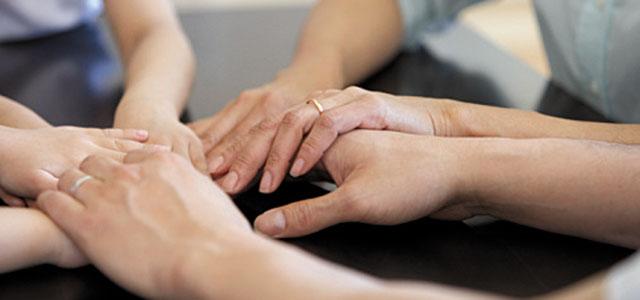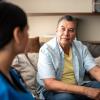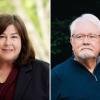
Neuro-Oncology CNS Margaretta Page Spearheads Innovative Program to Care for the Caregivers
Growing up as the oldest in a family of seven children, Margaretta Page found that caring for others came naturally, so it was no surprise to anyone when, in college, she decided to become a nurse. She wound up in neuroscience nursing and today is nurse coordinator of an innovative new program that provides support for caregivers of patients with brain tumors.
An Unexpected Career in Neuroscience Nursing
In 1984, with her BSN from Saint Louis University in hand, Page found that the job market wasn’t quite what she had expected. “When I started nursing school, there was a nursing shortage, and they told us, ‘You can live anywhere and work any shift,’ which was very appealing,” she says. By the time Page graduated, the shortage had become a glut, and she didn’t have many choices for employment. She took the only nursing job she could get – in neurology – and after a move to the West Coast, she began working on the neurosurgery/neurology floor at UCSF Medical Center. “Darn if I didn’t love it,” she says.
Three years in that role convinced her to pursue a master’s in neuroscience nursing at UC San Francisco School of Nursing, which she completed in 1989. Two years later, she took a job as a clinical nurse specialist (CNS) in the UCSF Neuro-Oncology Clinic, which allowed her to broaden her clinical skills and piqued her interest in symptom management.
In collaboration with the Oncology Nursing Society, Page reviewed research on symptoms such as fatigue and sleep disturbances and then developed summaries to help nurses put evidence into practice. She says, “I really enjoyed that, reading the literature and working with a group of nurses who were committed to investigating what was out there and what we could recommend to others to treat symptoms.”
Working in the Neuro-Oncology Clinic also gave Page an opportunity to participate in research. She assisted with clinical drug trials, and helped develop and conduct research projects on quality of life for brain tumor patients. In 2013, with lead investigator Mary Lovely (assistant adjunct professor in the Department of Physiological Nursing), Page worked on a multi-institutional qualitative study that looked at the support needs of long-term survivors of brain tumors. “Looking at people’s experiences and what they did to cope helped my patient care,” says Page.
Building a New Program for Caregivers
Helping another set of “patients” cope is the focus of Page’s newest endeavor. As nurse coordinator for the UCSF Neuro-Oncology Gordon Murray Caregiver Program, she aims to provide personalized support to families and other caregivers for people with brain tumors, including education, access to resources and peer support networks.
The program grew from an increasing concern that even when patient care is excellent, the caregiver is too often an afterthought, Page says. “There was a gentleman who came to us and said, ‘You did a great job of taking care of my wife, but you did a lousy job of taking care of me,’” says Page. Not long afterwards, the wife of Gordon Murray, a glioblastoma patient, expressed a similar concern. “She really championed the cause of caregiving,” says Page. A subsequent three-year grant from Murray’s family allowed the Neuro-Oncology Clinic to develop the program. Page was tapped to help lead it.
“The [program acknowledges that] the caregiver is as important as the patient at the outset,” says Page. The team, which also includes a social worker and an administrative coordinator, interacts with the caregiver as soon as the patient comes into care, typically at diagnosis.
“It’s a little different, having someone like me come into the room and say, ‘I work with the team who’s taking care of this patient, but I’m here to take care of you, too,’” says Page. “That’s a little foreign to people, and we’re trying to normalize it.”
The team assesses each caregiver individually and develops a plan of care that allows them to follow the caregiver over the trajectory of a patient’s illness, from diagnosis and treatment through transitions from hospital to home or from home to hospice. “A big part of what I do is help people figure out who to call for what – [help them] advocate for themselves or the patients,” says Page.
Making Connections and Sharing Resources
She also spends a large portion of her time building bridges between groups and organizations with similar interests, to try to expand access to resources for caregivers. For example, she works with the Oncology Nursing Society’s caregiver burden and symptom management teams and with the UCSF Helen Diller Family Comprehensive Cancer Center and other oncology departments to identify available services and look for opportunities to fill gaps.
Another collaborative project is the Neuro-Caregiver Collaboration, a group of providers and caregivers from the Murray Caregiver Program, the UCSF Memory and Aging Center and the Brain Injury Network of the Bay Area that meets to share resources and best practices and holds an annual conference for professionals, patients and caregivers.
Page and her colleagues are also working on a book for caregivers to help them cope with the progression of a loved one’s disease. “It’s a book about symptoms and what to expect as the disease progresses, and how someone dies,” says Page. “A person with a brain tumor dies differently than someone with lung or colon cancer. Because the disease is in the brain, there are a lot of cognitive symptoms, and there are nuances to how you treat them.”
Cognitive symptoms can be particularly challenging for caregivers, and they may need additional support. Even professional caregivers, like hospice workers, may need more information on caring for brain tumor patients, says Page, so she hopes to get funding to make the book available to hospices and to provide on-site training.
Recognizing the Value of Caregivers
Changes in health care make programs like Murray Caregiver Program even more important, says Page. “People used to be in the hospital for a week after brain surgery, so caregivers had a lot of support to get the skills they needed. Now they’re going home after three days. Caregivers are being asked to do a lot more.”
Thus, Page and her colleagues are looking for ways to make the caregiver program sustainable. Because there is currently no reimbursement for the kinds of services the program provides, it’s completely donor-funded, and Page is applying for grants that could help the program expand. She hopes eventually that payers will reimburse programs like hers – but first she and others must quantify and document the value. “Caregiver confidence and competence affects the quality of care the patient receives, and that affects cost,” says Page, giving the example of a caregiver who feels comfortable managing a seizure at home rather than rushing to the emergency department.
Because there aren’t yet many similar programs, Page hopes that Murray Caregiver Program can serve as a model for formally recognizing caregivers’ value and their needs. “This is patient care,” she says, “but the caregivers are my patients.”



